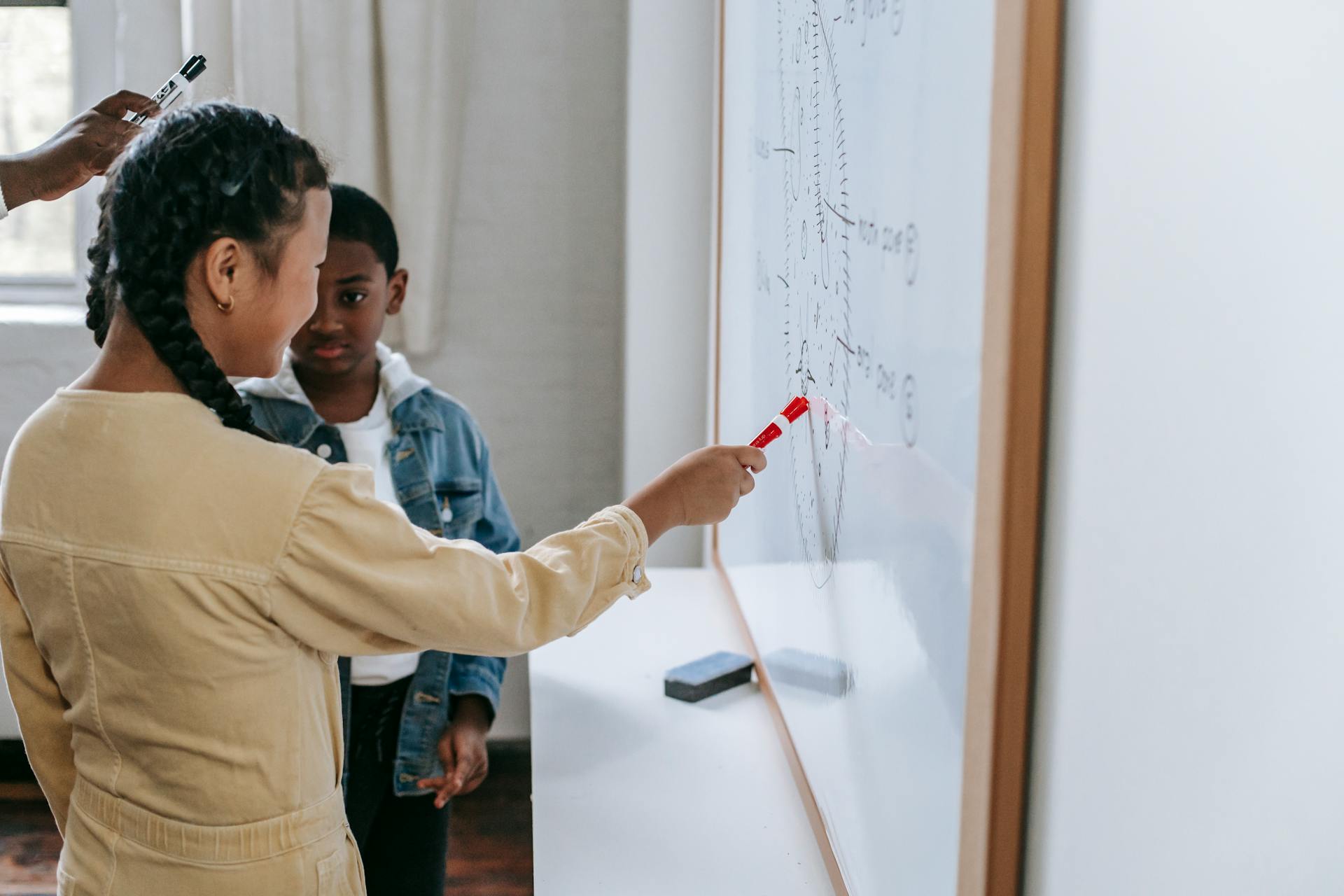
Learning from demonstration is a powerful approach in robotics and automation that allows machines to learn from human examples. This method is particularly effective in tasks that require precise movements, such as assembly or surgery.
In a study on robotic assembly, researchers found that a robot learned to assemble a complex product in just 10 attempts, with human demonstration and feedback. The robot's accuracy improved significantly after each attempt, demonstrating the efficiency of learning from demonstration.
By mimicking human actions, robots can develop the ability to perform complex tasks with ease. This approach is also being used in areas such as healthcare, where robots are being trained to perform delicate procedures.
Check this out: Learn Assembly Code
What is LFD?
Learning from demonstration, or LfD, is a way to teach machines by showing them how to do things. It's like having a teacher show you how to ride a bike.
The goal of LfD is to find a learner policy that can mimic the behavior of a demonstrator policy. This is done by minimizing a loss function with respect to the demonstrator policy on the state distribution induced by the learner.
In LfD, the learner's policy is compared to the demonstrator's policy on the state distribution, which is a way of measuring how well the learner is doing.
Formalizing LfD
LfD, or Learning from Demonstrations, is a field that aims to find a learner policy that matches the behavior of a demonstrator policy. The goal of LfD is to find a parameterized learner policy that minimizes a loss function with respect to the demonstrator policy on the state distribution induced by the learner.
In formalizing LfD, we define states and actions as and respectively, and a trajectory or rollout as a sequence of these. The demonstrator policy induces a trajectory distribution and a state distribution at each time step.
LfD seeks to find a learner policy that matches the state distribution induced by the demonstrator policy. However, this can be challenging when there's limited or no access to the state distribution and the trajectory distribution.
Behavioral Cloning Passively
Behavioral Cloning Passively is the simplest form of Learning from Demonstrations (LfD). It involves the learner trying to minimize the loss function in the demonstrator-induced distribution of states.
This method learns the mapping between the state and action pair in the demonstrations fed to it. However, the applicability of Behavioural Cloning is terribly limited in the real world.
The main issue is that Behavioural Cloning violates the i.i.d assumption of supervised learning. This is because the subsequent states depend on the previous states and actions, causing the learner error to keep accumulating.
As a result, the learner-induced and demonstrator-induced distribution of states become inconsistent. This problem grows in the order of O(n) in a n-step horizon of episodes.
Behavioural Cloning can be made to work well by gathering demonstrator actions from nearby states to the current one. This can be achieved by maintaining a 3-camera setup or using a gaussian noise to generate additional data.
Here are some key limitations of Behavioural Cloning:
- Limited applicability in the real world
- Violates the i.i.d assumption of supervised learning
- Causes learner error to accumulate
- Results in inconsistent learner-induced and demonstrator-induced distribution of states
- Requires exhaustive demonstrations across the whole state-space of interest
Types of LFD
Learning from demonstration (LfD) methods can be broadly categorized into three kinds. These categories help us understand the different approaches to learning from demonstrations.
LfD methods can be categorized into three kinds: behavioural cloning, active behavioural cloning with an interactive demonstrator, and inverse reinforcement learning. Behavioural cloning is a passive approach.
In this blog post, we'll cover the first two categories of LfD, which are behavioural cloning and active behavioural cloning with an interactive demonstrator. These approaches are essential in understanding how LfD works.
Here are the three kinds of LfD methods:
- Behavioural cloning
- Active behavioural cloning with an interactive demonstrator
- Inverse reinforcement learning
LfD methods can be categorized into three kinds, each with its own unique approach to learning from demonstrations.
Benefits and Implementation
Learning from demonstration can be a game-changer for many industries, but what are the benefits, and how can you implement it in your own organization?
By automating tasks and processes, companies can save time and reduce errors, as seen in the example of a robot learning to assemble a car by watching a human do it. This leads to increased productivity and efficiency.
One of the key benefits of learning from demonstration is that it allows robots and machines to learn new tasks quickly, reducing the need for extensive programming.
Explore further: Demonstration Learning Method
Why Do We Need LFD
LfD has three major advantages over other learning paradigms. Communication of intent is easy with LfD, which makes it more enticing to adopt.
Reward functions are hard to design, but LfD techniques allow communication of intent easily. This is especially true when methods that leverage demonstrations are considered.
Finding a good control solution is hard, and so is exploration. Often, the converged solution is not the best possible achievable answer. However, conveying the best solution through demonstrations is an easier task.
LfD can effectively communicate how to avoid catastrophic errors, which is unacceptable in the real world. This is especially true when learning from scratch necessitates making a catastrophic error to know that it was bad.
Here are the three major advantages of LfD:
- Easy communication of intent
- Improved finding of good control solutions
- Reduced risk of catastrophic errors when learning from scratch
Minimal Human Effort
LfD techniques allow communication of intent easily, making it a more enticing option compared to other learning paradigms.
Designing reward functions is hard, but LfD methods make it easier to convey intent through demonstrations.

In the real world, this phenomenon has been observed with the Fosbury Flop, where demonstrations effectively communicated the best solution.
LfD can effectively communicate how to avoid catastrophic errors, which is unacceptable in the real world.
This is especially true when learning from scratch, as it can be time-consuming and dangerous.
Here are the three major advantages of LfD over other learning paradigms:
- Easy communication of intent
- Conveying the best solution through demonstrations
- Effective communication of how to avoid catastrophic errors
Conclusions and Discussion
Learning from demonstration is a promising approach to teaching robots practical skills, but it's not without its challenges. Requiring non-experts to demonstrate one movement in a repetitive way is not a good solution.
The quantity of demonstrations is often limited, and the demonstration may contain noise, making it hard for non-expert users to use Learning from Demonstration (LfD). Due to the lack of some movement features and the intuitive nature of interacting with human demonstrators, the learning process can be unidirectional and lacking timely revision.
The robot can learn a skill from a demonstrator, but the skills that the robot has learned are parallel, not progressive or incremental. This means that the robot can't use the skills it has learned to learn more complicated skills.
Recommended read: Robot Learning
One promising solution to improve the learning process is to provide the human demonstrator with a way to give timely feedback on the robot's actions. This can be done through a GUI, but more research is needed to determine the best way to provide effective feedback information.
The goal of robotics assembly is to promote industry productivity and help workers with highly repeated tasks. However, the robots are currently limited to individual subskills of assembly, such as inserting, rotating, and screwing. To overcome this limitation, future research work should focus on combining these subskills into smooth assembly skills.
Here are some key areas that require further research:
- Generalizing through a limited number of feature samples
- Incremental learning features for robotic assembly
- Effective demonstration and feedback mechanisms
- Combining subskills into smooth assembly skills
- Improved evaluation metrics for LfD
Frequently Asked Questions
Is imitation learning the same as learning from demonstration?
Yes, imitation learning and learning from demonstration are interchangeable terms, referring to the process of learning from expert examples. This approach enables agents to learn complex tasks by mimicking expert behavior.
Sources
- https://www.mdpi.com/2218-6581/7/2/17
- https://pubmed.ncbi.nlm.nih.gov/35408292/
- https://ori.ox.ac.uk/news/learning-from-demonstration-with-minimal-human-effort/
- https://research.wur.nl/en/publications/using-learning-from-demonstration-lfd-to-perform-the-complete-app
- https://sanjaykthakur.com/2018/12/23/learning-from-demonstrations-i/
Featured Images: pexels.com


